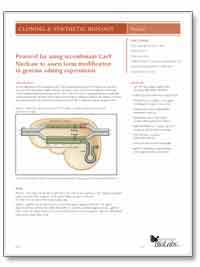Genome editing is enabled by the development of tools to make precise, targeted changes to the genome of living cells. Recently a new tool based on a bacterial CRISPR-associated protein-9 nuclease (Cas9) from Streptococcus pyogenes has generated considerable excitement. This follows several attempts over the years to manipulate gene function, including homologous recombination and RNA interference. RNAi, in particular, became a laboratory staple enabling inexpensive and high-throughput interrogation of gene function, but is hampered by providing only temporary inhibition of gene function and unpredictable off-target effects. Other recent approaches to targeted genome modification — zinc-finger nucleases [ZFNs] and transcription-activator like effector nucleases [TALENs]– enable researchers to generate mutations by introducing double-stranded breaks to activate repair pathways. These approaches are costly and time consuming to engineer, limiting their widespread use, particularly for large scale, high-throughput studies.
CRISPR (Clustered Regulary Interspaced Short Palindromic Repeats) and CRISPR-associated (Cas) genes are essential in adaptive immunity in select bacteria and archaea, enabling the organisms to respond to and eliminate invading genetic material.
The simplicity of the CRISPR nuclease system, with only three components (Cas9 , crRNA and trRNA) makes this system amenable to adaptation for genome editing. By combining the crRNA and trRNA into a single synthetic guide RNA (sgRNA), a further simplified two component system can be used to introduce a targeted double stranded break. This break activates repair through error prone non-homologous end joining (NHEJ) or Homology directed Repair (HDR). In the presence of a donor template with homology to the targeted locus, the HDR pathway operates allowing for precise mutations to be made. In the absence of a template, NHEJ is activated resulting in insertions and/or deletions (indels) which disrupt the target locus.
For in vitro applications NEB offers recombinant Streptococcus pyogenes Cas9 Nuclease.
in vivo Gene Editing in Zebrafish
– NEBs Cas9 in microinjection in customer experiment
|
„„The experiments with NEB Cas9 are going well, seems very effective with a variety of sgRNAs. The high conc. Cas9 protein (Anm.: #M0386 M) is extremely efficient in vivo!““ James A. Gagnon, Department of Molecular and Cellular Biology, Harvard University, USA |
||||
 |
||||
Mutations in the tyrosinase gene block melanocyte pigmentation in zebrafish: 1-cell embryos were injected with 10 sgRNAs targeting tyrosinase and NEB 18 μM Cas9 protein. Categories of pigmentation at 3 days post fertilization. At 2nl injection volume, >90% of embryos completely lack pigmentation.
Images and data by courtesy of James A. Gagnon, Department of Molecular and Cellular Biology, Harvard University, USA
Further online ressources:
Plasmid Repositories:
http://www.addgene.org
CRISPR-gRNA Design Tools:
http://crispr.mit.edu
http://zifit.partners.org/ZiFiT/
http://www.e-crisp.org/E-CRISP/designcrispr.html
https://chopchop.rc.fas.harvard.edu/
Online Forums:
https://groups.google.com/forum/crispr
Organism-specific Resources:
http://wormcas9hr.weebly.com
http://www.flyrnai.org
D O W N L O A D S
Article
“CRISPR/Cas9 and Targeted Genome Editing:
A New Era in
Molecular Biology”

Application Note
“Protocol for using recombinant Cas9 Nuclease to assess locus modification in genome editing experiments”

Application Note
“Construction of an sgRNA-Cas9 expression vector via single-stranded DNA oligo bridging of double-stranded DNA fragments”






